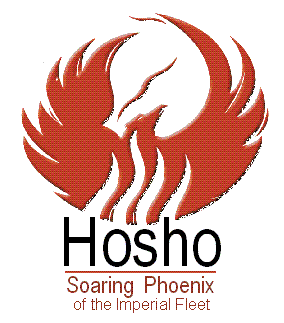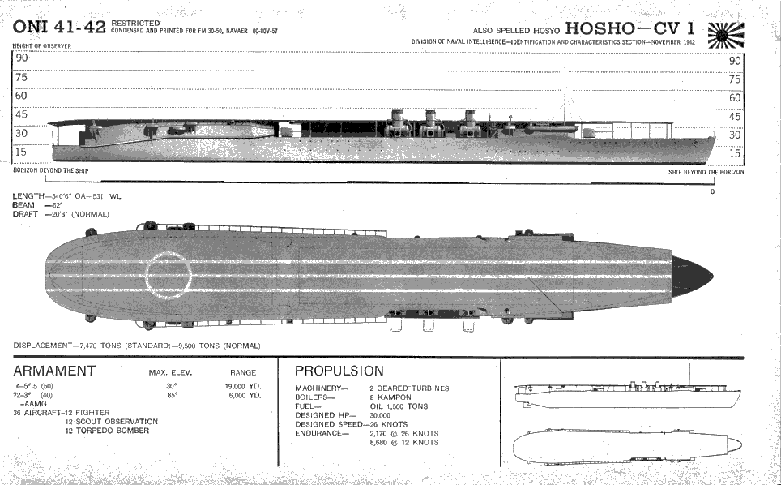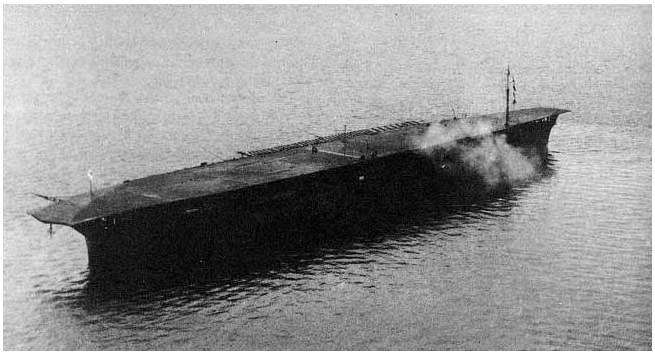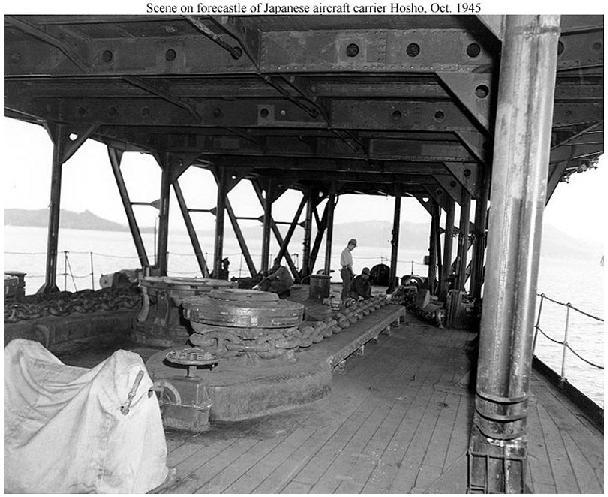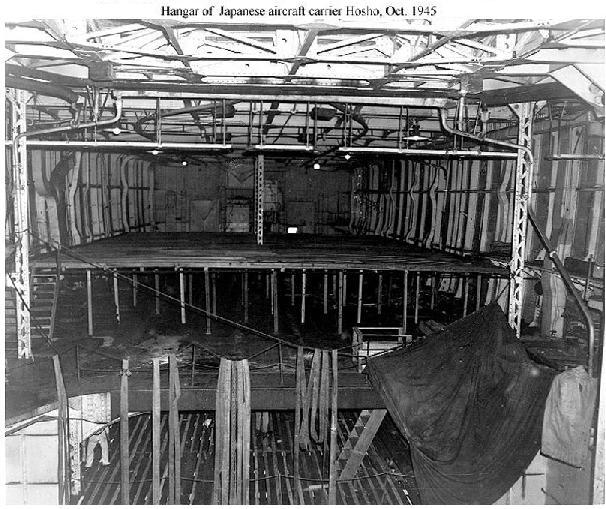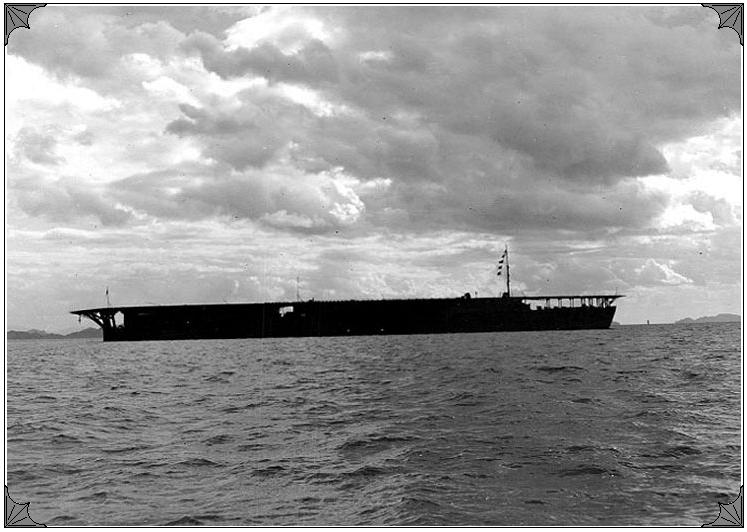
Imperial Japanese Navy - HOSHO Aircraft Carrier ==========================================================================
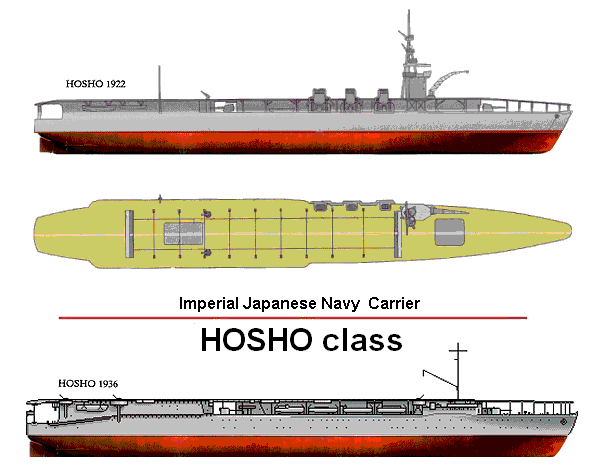
Hôshô ("soaring phoenix") became the first flat-deck aircraft carrier of the Imperial Japanese Navy in 1921, and was the first purpose-designed aircraft carrier in the world to be commissioned.
Her predecessors in the Imperial Japanese Navy were seaplane carriers such as the Notoro, or the Wakamiya.
The Hôshô was initially ordered as an oil tanker with the designation Hiryu under the 8-6 Fleet plan, but during construction in 1920 it was decided to redesign the ship as an aircraft carrier and the name was changed to Hôshô.
The hull of the Hôshô was based on a cruiser design, but it was not a conversion. She was built from the keel up as an aircraft carrier. Hôshô was commissioned on 27 December 1922, thirteen months before the Royal Navy's first purpose-built carrier Hermes, which was designed before Hôshô. The Hôshô however was originally conceived as a mixed aircraft carrier and seaplane tender and only during construction was her design modified to a dedicated carrier. She was the first purpose-designed aircraft carrier.
It is believed that the British Semphill Mission, in Japan at the time, influenced the design of the Hôshô. Regardless, the Hôshô was the first ship completed that was specifically designed from the keel for the role of aircraft carrier. The HMS Hermes designed at the same time was not completed until a year after her Japanese equivalent. When Hôshô was commissioned in 1922 she became the first carrier to be completed. Although HMS HERMES was designed first, construction proceeded at a leisurely pace and the Hôshô entered service before her.
The Hôshô was designed with the assistance of a British technical mission which provided broad details of the Hermes.
Aviation in Japan began with the importing of several foreign designs for experimental purposes. Within ten years of its inception military aviation in Japan was well organized with the Army and Navy establishing separate air services and importing technical missions to help speed up progress. It was generally believed in Japan that the French were better equipped with land based aircraft while the British were more advanced in Naval air. Thus, the Army brought in a French technical mission, with some SPAD XIII aircraft, while the Navy requested British assistance. The British technical mission, called the Sempill Mission after its leader, arrived in Japan in September of 1921.
A group of 29 instructors under Capt. Sempill began training operations at the Navy's first air base at Kasumigaura. Several new aircraft types, including the Gloster Sparrowhawk, were introduced and for over a year intensive training was carried out in flight control, torpedo bombing, squadron tactics and in numerous technical courses. The influence of this mission was profound and contributed to rapid progress in organizational and operational efficiency. They also were of assistance to the ship designers as they brought with them plans of the latest British aircraft carriers, ARGUS and HERMES. These were state of the art at the time. ARGUS was the first flush deck carrier and HERMES was the first aircraft carrier to be designed as such rather than being converted from another hull. These plans had an influence on the design of the first Japanese carrier Hôshô.
Commissioned in 1922 at Asano Shipbuilding Yards in Tsurumi, the Hôshô originally had an 'island' on her starboard side which served as a command deck and flight observation tower. It proved unsatisfactory for both purposes in air trials and by 1923 was replaced with a bridge on the starboard side forward under the flight deck, giving her a flush-deck design. This also allowed for the flight deck to be widened further. The Hôshô was also equipped with three hinged funnels, designed to rest horizontal or vertical depending on the requirements at the time. Eventually the funnels were fixed in an upright position. Other modifications to the Hôshô included lengthening the deck from 519 ft to 579 ft and 5 in, in 1944.
The first take off from the Hôshô's deck occurred on 22 February 1923 by a Mitsubishi 1MF Type 10 fighter, one of three aircraft specifically designed to operate on the carrier. The other two were the Mitsubishi 2MR Reconnaisance plane, and the 1MT torpedo tri-plane.The first landing on the Hôshô was made by a British civilian, a Mr. Jourdan, a day later on the 23 of February. The initial landing system used on the Hôshô was based off the British method of longitudial wires running the length of the deck, in addition with the cross deck wire. The system resulted in more annoyance than benefit and was scrapped in favor of the traditonal cross deck arresting cables.
From the date of her commission in 1922 to the completion of the Akagi in 1927, the Hôshô served as the most advanced aircraft carrier in the Imperial Navy. In 1933, she was withdrawn from the regular fleet and assigned as a training vessel. She remained in this capacity until the outbreak of the Pacific War and assisted with a compliment of older aircraft in operations along the Chinese coasts in 1940.
Photographs of Hôshô with aircraft on deck or in the air seem to show only the Type 10 fighters. It is almost certain that the other standard aircraft types would have been operated, at least experimentally, from the Hôshô.

The Hôshô provided valuable experience for the subsequent conversions of Akagi and Kaga into aircraft carriers, and was influential in the design of the Ryûjô, the first Japanese aircraft carrier purpose built from keel up.
Being the first of its kind in the navy, Hôshô was actively used to develop the aircraft carrier operational methods and tactics of the Japanese Navy during the 1920s. She was preceded by the 1913 early seaplane carrier Wakamiya, which contributed to the development of the carrier techniques used in the Hôshô.
The carrier Hôshô underwent many changes during her career. The starboard mounted bridge structure was removed in 1923 and she became a flush deck carrier. This carrier style, totally flush deck with no bridge, was to be repeated many times in the Imperial Navy. The bridge was discarded because pilots found it interfered with their vision and it was too small for the officers to effectively command flight operations. Side gallery platforms were added for directing operations. This new arrangement was well liked by both pilots and deck officers. A radio mast was mounted on the gallery on the starboard side after the bridge structure was removed. Later this was replaced with a larger one, then removed altogether.
The landing system originally installed was the British WWI system, or "the Trap", consisting of a combination of longitudinal wires and the more familiar across deck arrester cables. On early British carriers, such as HERMES, the area where the wires were strung was actually sunk slightly below the remaining deck level. Aircraft coming aboard would drop into this depressed area, hooks on the undercarriage would engage the longitudinal wires, while the tail hook would engage the across deck wires. The idea of the longitudinal system was to keep the aircraft traveling in a straight line while the aft tailhook brought it to a stop. What more often happened in practice was that the landing gear hooks caused the aircraft to nose over on landing. Many early carrier pilots were missing their front teeth, considered an occupational hazard, from nose overs and sudden contact with the forward cockpit coaming or protruding machine gun butts. Experiments soon showed that the "trap" was unnecessary and in both the IJN and American Navy, (on the USS LANGLEY), this system was removed and replaced with a simpler system of across deck arrester cables. The British, perhaps because they invented it, hung on to the older system for a much longer time.
The three funnels were originally designed to hinge and to fold down to a horizontal position during flight operations, a feature shared with the USS LANGLEY. Sometime in the late twenties, the funnels were permanently fixed in the horizontal position. With the elimination of the folding feature, the deck was extended over the funnels; gaining several feet in width. The forward portion of the flight deck sloped downward when the ship was first completed. Later this portion of the flight deck was raised almost to the horizontal with only a very slight downward angie remaining. As aircraft size and speed increased, Hôshô was becoming too small for safe flight operations. About 1944 the deck was extended both forward and aft to allow her to be able to operate higher performance aircraft.
Numerous detail changes also occurred. When built, Hôshô was armed with four 5.5" guns and two 3" anti-aircraft guns. At the outbreak of the War with America the 3" guns were removed and were replaced with four twin 25mm gun mounts. Sometime during the war, the 5.5" guns disappeared and the 25MM guns were increased to ten triple 25MM mounts. Near the end of the war, after Hôshô was damaged by bombing, the 25mm guns were reduced to two triple mounts and she was thus armed when surrendered at Kure in 1945.
Over her career, efforts were also made to lengthen and widen her flight deck, so the ship could handle newer and more aircraft. However the overhang weakened her stability and ocean-going capability and she was relegated to a training ship in 1942.
During much of the 1920s Hosho was Japan's only flat-top. Like the U.S. Navy’s USS Langley (CV-1), was actively employed developing carrier operational techniques and tactical doctrine. Though far more capable ships came along during the later 1920s, she continued in operation through the remainder of the Imperial Navy's existence.
The Japanese Navy was a pioneer in naval aviation, having commisioned the world's first built-from-the-keel-up carrier, the Hosho. Throughout the 1920's and 1930's, they constantly experimented with their carriers, perfecting their design and construction methods, and honing the demanding art of blue-water power projection. They also put in place a tremendously selective and rigorous pilot training program. As a result, by the time Japan attacked the United States, they possessed a fantastically effective naval aviation force, comprised of a core of six large carriers and several more light carriers, whose airwings were manned by long-serving, highly-skilled pilots. For the first six months of the war, this force would roam the Pacific with near impunity, destroying their opponents almost at will. And even well after the debacle at Midway, Japanese carriers and their airwings retained a formaidable punch.
Hôshô served in the combined fleet from 1922 to 1933 when she was withdrawn and used for training duties. During the 1938-39 period Hôshô received a full air complement, (of obsolete types), and was employed again with the Combined Fleet and saw action in the China War. In 1940 she again reverted to the training role and remained so employed until after the Pearl Harbor attack. Shortly thereafter Hôshô was reequipped with modern aircraft, (exact numbers and types not known for certain), and was assigned to the 3rd. Carrier Division along with the Ryujo. After a few minor operations she took part in the Battle of Midway as part of the main fleet. She then returned to home waters and was reassigned to the training role for the duration of the war. This second line employment is probably what saved her, for she was usually operated away from the main fleet anchorages and was overlooked in the wide ranging air sweeps by US Navy aircraft towards the end of the war. At war's end she was still afloat although she had sustained some bombing damage in 1945.
She served during the Shanghai Incident (bombing of Shanghai on 28 January 1932) and Sino-Japanese War in 1937. In August-December 1937, Hôshô supported land operations of the Japanese Army in China, as part of Carrier Division 1 with Ryûjô. Her aircraft complement consisted of nine Nakajima A2N fighters and six Yokosuka B3Y1 attack planes.
By the beginning of World War II, Hôshô had been superseded by other models: since she was too small and too slow to accommodate the newest types of carrier planes such as the Mitsubishi Zero. Moreover, the Hôshô did not have enough margin of stability to carry her full armament and aircraft complement. She saw action however during the battle of Midway in June 1942, offering modest air support to the main fleet. Her aircraft complement consisted of eight Yokosuka B4Y1 "Jean" torpedo bombers.
At the outbreak of WW II, her high angle guns were replaced by four 25mm twin mount machine guns. Later, the 14cm guns were removed and 25mm double or single mount machine guns were added. During much of the war, however, the Hôshô was used primarily for training purposes, but did serve in an air defense capacity at the Battle of Midway in 1942. Three years later, she sustained damage during an American air attack on Kure, Japan.
For most of the postwar years, the assumption was made in English-language publications that the ship had been equipped with a 'modern' aircraft complement by the time of the Midway operation, on the basis of minimal translations published in English. However, beginning in the 1980s English-language researchers realized that this was a bad assumption, as Japanese official histories and air orders of battle began to appear. It has now become clear that at the time of Midway, Hôshô still carried a complement of the fixed landing gear biplane torpedo planes, the "Jean". It was one of these aircraft which took the photos of the burning, drifting Hiryû in the late afternoon of 4 June 1942.
After her withdrawal in June 1942, she was relegated to training duty in Japan's Inland Sea after 1943. Subsequently she was damaged by grounding in 1944 and hit by American bombs at Kure, but remained afloat by the end of World War II after being laid up for lack of airmen to fly her aircraft. Post war, she served as a transport conduit to repatriate Japanese soldiers and civilians back home from the many outlying island garrisons which had been bypassed in the American drive across the Pacific. Hôshô served in this role until August 1946. Upon completing this mission, she was scrapped in 1947. Hôshô was one of only four carriers of the Japanese Navy to survive the war. Thus Hôshô was both the first and the last Imperial Japanese carrier.
=================================================================================
NB: The above text has been collected / excerpted / edited / mangled / tangled / re-compiled / etc ... from the following online sources :
IJN Aircraft Carrier Hosho - wikipedia article
IJN Hosho Light Aircraft Carrier - www.globalsecurity.org
HOSHO ('Soaring Phoenix') - www.smmlonline.com
IJN Aircraft Carriers - www.combinedfleet.com
